This is a reprint of an article by Mary Rodgers, originally appearing in the newsletter of The Clintonville Historical Society.
A brief history of Charles T and Sadie M. Legg–long time Clintonville residents–based on The Booster news article dated February 12, 1937, with additions
Charlie Legg was born on the Legg farm on April 23, 1871. This farm, a dairy, was located North of Clintonville. The lane leading to the Legg homestead would have been near where Webster Park Avenue is today.
Charlie’s mother was Orell E. Webster, daughter of Amazon Webster and a direct descendant of Noah Webster of American Dictionary fame. His father was Lewis Legg, believed to be the son (or grandson) of Elijah Legg, a revolutionary war soldier from Massachusetts who settled in Ohio in 1815.
In 1937, Charlie reported that when his grandfather, Amazon Webster, moved to Clinton Township, Indians lived in the section now known as Indian Springs. Those Indians raised cranberries. Amazon told his grandchildren that the Indians would walk to Chillicothe to sell their berries.
Charlie’s grandmother was Mary Pinney of Worthington. She was the daughter of Levi Pinney and Charlotte Beach. Levi and Charlotte were the first couple to be married in Worthington, Ohio. That was 1839.
Sadie Mitchell was born on January 27, 1874 in Circleville. Her father was a builder. She became Charlie’s blushing bride on Thanksgiving Day, November 24, 1892. When she heard of the upcoming wedding, Sadie’s grandmother exclaimed, “Oh that name!” Sadie’s response was that it was no worse than the last four letters of her present name!
The Leggs were married by Rev. Louis Postle and their first home was behind Dr. Burbacher’s Offices, which were located on the Southeast corner of Oakland Park and High. The Mennonite Church stands here today. It was reported that after a year, in 1894, they moved to into a building that had been a church at the Northeast corner of Walhalla and High street (Clinton Chapel–now Southwick-Good and Fortkamp Funeral Home). They started a dairy farm. After a year, they moved to property located west of the Olentangy River near what is now Lane Avenue. Here they set up a “business” farm including the sale of corn to the Sells Circus. Today, if you are driving north on Kenny Road from Lane Avenue, you will see a road called Legg.
When Charlie’s father could no longer care for his farm, Sadie and Charlie combined their operation with his and moved to the North Clintonville homestead. In 1907, the Leggs sold the farm to developers Thompson, Johnson and Thompson. The neighborhood called the Webster Park Addition was platted. The Leggs built and sold three homes in this development. Orell Webster Legg, Charlie’s mother, retain the portion of the farm closest to the river. In 1909, a portion of her property was set aside for a bird sanctuary. We call this area the Delta.
According to the 1914 records, 346 families, a population of 1,190, represented Clintonville. The Clinton League Memory Book reports:
In 1913, a new two story brick building was erected on the corner of Dunedin Road and High Street. It was haled with delight by residents of the neighborhood for at this place Mr. Legg opened a grocery store and Mrs. Legg had a department for notions-live-savers they were where you lived five miles from town. There were two business rooms in this building so the post-office was moved to the one adjoining the store. It remained there until 1917 when rural mail delivery was established.” Today, this building houses Shim’s tailor and Melissa’s Incredible Edibles.
On July 4, 1916, Sadie’s dry goods business moved to 3339 North High. That building was built in 1910 by J. C. Loren. The Booster reported him as a well known contractor at the time. He may have built some of the early homes on East North Broadway. In fact, the home that was located at 615 East North Broadway, the carriage house for that home still stands and is know the Fisher home, was referred to as the Loren home in the Clinton Memory Book. We know that the developer of North Broadway, James M. Loren, never lived on North Broadway, so perhaps 615 was J. C. Loren’s home. Before Sadie, the 3339 North High building was occupied by Swope’s Grocery and Bilikam’s Grocery. Bilikam’s later moved to North Columbus. In 1918, the Leggs bought the building and Sadie operated her dry goods store at the site until February of 1937. Later in life, Sadie lived in the apartment above the store.
Mr. Legg, after selling his grocery, was a city salesman for the E. E. Shedd Mercantile Company and then worked for the L. E. and C. W. Medick Co., Ford Dealers in the Clintonville community. In fact, at her retirement in 1939, Sadie said that to get full enjoyment from her upcoming vacation, she would need a new V8 Model Ford. Charlie commented that he wouldn’t be receiving a commission on the upcoming sale.
The Leggs told The Booster that they recalled when a saloon existed at what would now be the southwest corner of Orchard Lane and High Street (the Kroger parking lot). The story is that while there were a dozen saloons in North Columbus, there were none in Clintonville. Then a man was elected mayor of Columbus who closed the saloons on Sunday. This drove the liquor dealers to move outside the city. In those days there was a “one-mile limit” law which meant that city police could arrest people within one mile of the city limits. So the new saloons were set up, including the one here. The local place did a “land-office business. ” The mayor found out however that the Clintonville saloon was a few feet inside the one mile limit. (The city limit at the time was Mock Rd–now Arcadia Ave.) So, on a Sunday morning he sent the “Black Maria,” as it was called in those days, to get the drunkards and the proprietor. A new mayor reopened the City saloons on Sunday and the Clintonville establishment failed.
When interviewed by The Booster in 1937, the Leggs recalled the tollgate that used to block High Street just north of Arcadia. The gate had a 3 cent per rig fee. They also recalled when “…there was no such a thing in those days as cross streets coming into High Street, except North Broadway. So the cars stopped at numbered stops…a pleasant memory when one thinks again of Stop 6 (now Pacemont–once known as Jason Avenue); Stop 7, (now Como); Stop 8 (North Broadway); Stop 9 Clintonville (Oakland Park). And then the stops were farther apart, and little used until one reached Cooke’s Corners (Cooke Road).”
Charlie and Sadie are buried in Walnut Grove cemetery on the south side of Worthington. Charlie passed in October of 1946 and Sadie in November of 1957.
Side note: One of Charlie’s sisters, Emma, married James Harvey Zinn, born 1 October 1871 Ohio, in 1895. J. Harvey Zinn was the President of the J. H. Zinn Lumber Company of Columbus, Ohio. Mr. Zinn was reported to be an ardent fisherman who followed his favorite sport in practically every part of Canada, as well as in Florida waters. His attractive estate “Edgewater,” was located on the Olentangy River just north of West North Broadway. This estate still exists in Clintonville; for more information listen to Robert Ohaver’s oral history.
[Article courtesy of Mary Rodgers and the Clintonville Historical Society]
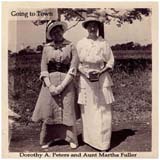
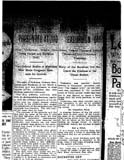 The zoo in Beechwold may have been one of the earliest sites of the Columbus Clippers!
The zoo in Beechwold may have been one of the earliest sites of the Columbus Clippers! 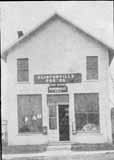 Clintonville was never platted as a formal village. Alanson Bull, the son of Thomas Bull, sold several small lots to tradesmen for their shops. Located at the northwest corner of High Street and Orchard Lane, a post office opened in 1847, in a two-story frame building on the northwest corner of High Street and Orchard Lane, and was given the name Clintonville because it was located at the center of Clinton Township. (This building has since been torn down.) The postmaster conducted a rag rug business upstairs. High Street at that time was a dirt and plank turnpike connecting Columbus with Worthington and Sandusky. In 1913 a new two-story brick building was erected on Dunedin at High. Mr. Legg operated a grocery store; Mrs. Legg sold notions. The post office moved there and remained until 1917—when, according to one source, RFD was offered, and according to another source, because the area was annexed by the city of Columbus. (I believe this second post office was a small building behind the corner building.) (Photo courtesy of the Clintonville Historical Society)
Clintonville was never platted as a formal village. Alanson Bull, the son of Thomas Bull, sold several small lots to tradesmen for their shops. Located at the northwest corner of High Street and Orchard Lane, a post office opened in 1847, in a two-story frame building on the northwest corner of High Street and Orchard Lane, and was given the name Clintonville because it was located at the center of Clinton Township. (This building has since been torn down.) The postmaster conducted a rag rug business upstairs. High Street at that time was a dirt and plank turnpike connecting Columbus with Worthington and Sandusky. In 1913 a new two-story brick building was erected on Dunedin at High. Mr. Legg operated a grocery store; Mrs. Legg sold notions. The post office moved there and remained until 1917—when, according to one source, RFD was offered, and according to another source, because the area was annexed by the city of Columbus. (I believe this second post office was a small building behind the corner building.) (Photo courtesy of the Clintonville Historical Society)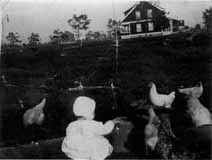
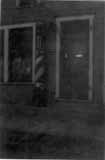 In 1918, after serving in WWI, Tom Pletcher came to Columbus hoping to find a job as a barber. Jimmy Kinnaird, a pharmacist at the corner of Brighton and North High Street, rented Pletcher a store room at the rear of the pharmacy. Pletcher ran the barbershop on Brighton (above) from 1919, and in 1921 moved to larger space at 3311 North High Street. After becoming ill, he sold the business in 1943 to a long-time employee named Bill Morgan. The barber shop moved again, in 1980 to 3325 North High Street. (Photo courtesy of the Clintonville Historical Society)
In 1918, after serving in WWI, Tom Pletcher came to Columbus hoping to find a job as a barber. Jimmy Kinnaird, a pharmacist at the corner of Brighton and North High Street, rented Pletcher a store room at the rear of the pharmacy. Pletcher ran the barbershop on Brighton (above) from 1919, and in 1921 moved to larger space at 3311 North High Street. After becoming ill, he sold the business in 1943 to a long-time employee named Bill Morgan. The barber shop moved again, in 1980 to 3325 North High Street. (Photo courtesy of the Clintonville Historical Society)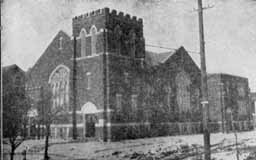 This is the newer Crestview Presbyterian Church, built in 1922 at Tulane and Esmond. (Photo courtesy of the Clintonville Historical Society)
This is the newer Crestview Presbyterian Church, built in 1922 at Tulane and Esmond. (Photo courtesy of the Clintonville Historical Society)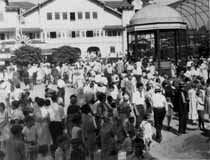
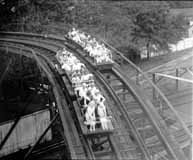


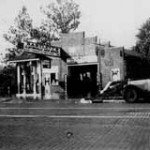
 David and Alta Korn built a home at 4891 High Street, in old Beechwold, in 1920. They had an adopted son named William. The family was adversely affected by the Great Depression and lost their Old Beechwold house in 1932. This photo shows Alta and a child along the river. William raised his family in Clintonville and died in 1986. (Photo courtesy of the Clintonville Historical Society)
David and Alta Korn built a home at 4891 High Street, in old Beechwold, in 1920. They had an adopted son named William. The family was adversely affected by the Great Depression and lost their Old Beechwold house in 1932. This photo shows Alta and a child along the river. William raised his family in Clintonville and died in 1986. (Photo courtesy of the Clintonville Historical Society) 